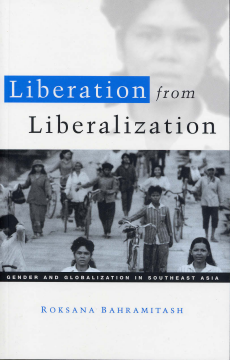
Additional Information
Book Details
Abstract
Liberation from Liberalization challenges the neo-liberal claim that free market policies bring prosperity and economic development. Bahramitash focuses particularly on Southeast Asia, where expansion of free markets has led to high GNP per capita growth over the past few decades. Focusing on this region, the book examines the economic policies adopted in Taiwan, Indonesia and the Philippines. Drawing upon state-centred theories, the author argues that limiting the role of the state has been responsible for growing poverty, especially among women. Seventy percent of those earning less than a dollar a day are women, and poverty among rural women is growing much faster than it is among men. In order to reverse economic liberalization, the state has to be brought back into the economy as a major player and become responsible for providing welfare for its citizens.
This volume argues in favour of a system that incorporates women's groups into the decision-making process of the state, while ensuring that the state remain both transparent and subject to the political advocacy of its citizens. Bahramitash argues that, ultimately, the only way to stop liberalization, which is trapping millions in poverty, is to limit the role of markets through an elected and responsible state with embedded members of civil society, such as women's groups.
Roksana Bahramitash is currently based in Montreal at Concordia University where she teaches courses on gender and development at the Simone de Beauvoir Institute Concordia Women Studies Program. Bahramitash was awarded her PhD from McGill University, Montreal, in 2001. She is currently researching her second post-doctoral project, funded by the Social Science and Human Research Council of Canada, (SSHRC), regarding globalization, islamization and women's employment.
'This study by Roksana Bahramitash is an excellent introduction for those wishing to learn more about the significance of gender issues in Southeast Asian economic restructuring. The author has first-hand knowledge of the key aspects of liberalization which place stresses on women, children and men under the guise of 'globalization' in Southeast Asia. I recommend this book to academics, activists and policy-makers as a thoroughly researched and fluent analysis relevant across various fields from anthropology, economics, politics and policy studies.'
Chris Corrin, University of Glasgow
'A rich empirical contribution with a provocative analysis... in my view there is much here for students and mature scholars alike.'
Dawn Currie, Asian Journal of Women's Studies
Table of Contents
| Section Title | Page | Action | Price |
|---|---|---|---|
| Contents | v | ||
| Tables and Figures | vii | ||
| Acknowledgements | ix | ||
| Introduction | 1 | ||
| 1. Market Fundamentalism | 19 | ||
| The post-Second World War development effort | 20 | ||
| The rise of neo-liberalism: embracing the market, reducing state power, more poverty | 27 | ||
| Alternatives to market fundamentalism: embedded autonomy and the interventionist state | 32 | ||
| 2. Who Pays for Market Fundamentalism? | 40 | ||
| Background to theories of gender and development | 41 | ||
| Women’s work as defined by the market | 43 | ||
| Neo-liberalism and increasing women’s employment | 45 | ||
| Women’s invisible contributions | 53 | ||
| Labour of love: the care economy and declining social services | 57 | ||
| The interventionist state versus market fundamentalism | 60 | ||
| Notes | 62 | ||
| 3. Taiwan: Neo-Liberalism or Developmentalist State? | 64 | ||
| Colonial history | 64 | ||
| The making of modern Taiwan | 69 | ||
| Women's role in Taiwan’s economic success | 77 | ||
| Invisible economic contributions | 91 | ||
| Community and volunteer work: state-initiated organizations | 96 | ||
| Gender politics, civil society and Taiwan’s future | 99 | ||
| Notes | 104 | ||
| 4. Indonesia: Paper Tiger and the Asian Crisis | 106 | ||
| Colonial history | 106 | ||
| Modern Indonesia: state structure and political economy | 112 | ||
| Women’s role in the economy | 120 | ||
| Notes | 135 | ||
| 5. The Philippines: Exporting Women Is Good for Growth | 136 | ||
| Colonial history | 136 | ||
| Modern Filipino state structure and development strategy | 146 | ||
| Women’s role in the economy | 155 | ||
| Notes | 171 | ||
| 6. Conclusion: Liberalization in Crisis | 172 | ||
| Challenging neo-liberalist assumptions | 172 | ||
| APEC and the unholy marriage of neo-liberalism and neo-conservatism | 179 | ||
| Neo-liberalism in crisis: looking into the future | 183 | ||
| Notes | 186 | ||
| Bibliography | 187 | ||
| Index | 201 |
